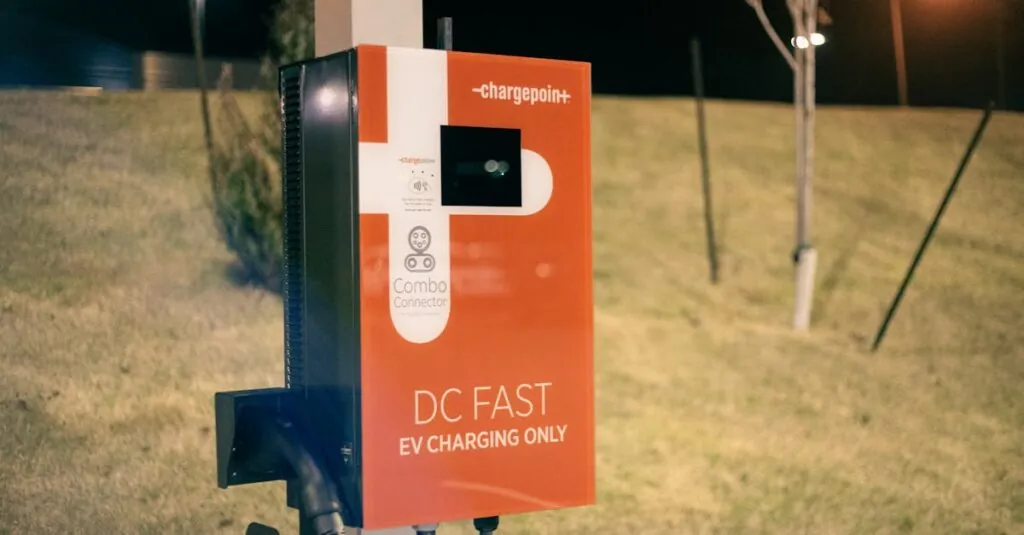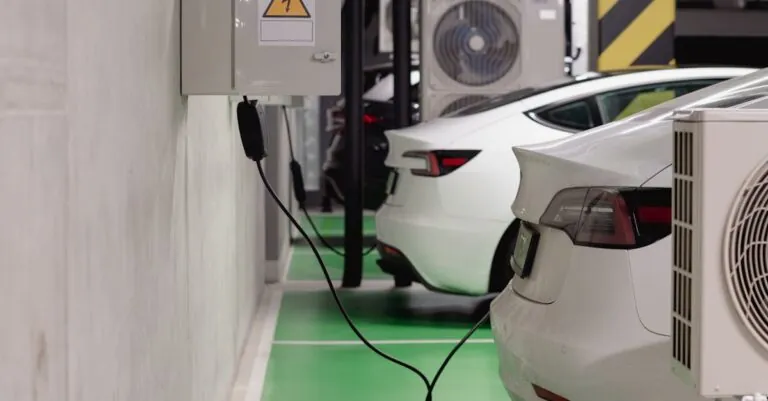Table of Contents
ToggleIn a world where time is money and patience is a virtue few can afford, DC fast charging swoops in like a superhero ready to save the day. Imagine plugging in your electric vehicle and watching it gulp down energy faster than a kid at an all-you-can-eat buffet. With the ability to charge up to 80% in just 30 minutes, DC fast charging turns long waits into quick pit stops, making road trips a breeze.
Overview of DC Fast Charging
DC fast charging represents a pivotal advancement in electric vehicle (EV) infrastructure. This charging method significantly reduces the time required to power an EV, providing about 80% charge within 30 minutes. Many users appreciate the convenience it offers, especially during long-distance travel.
Chargers use direct current (DC) to bypass the vehicle’s onboard charger, delivering high power directly to the battery. This speeds up the process compared to standard Level 2 charging stations, which typically take several hours for a full charge. Popular locations for DC fast chargers include highways and urban areas, ensuring drivers can find convenient access during road trips.
Power levels for DC fast chargers commonly range from 50 kW to 350 kW. This variability allows flexibility in meeting different vehicle needs and optimizing charging times. For instance, Tesla’s Supercharger stations commonly provide 120 kW to 250 kW, while other networks like Electrify America offer options up to 350 kW.
Certain factors affect charging speed, including battery capacity, state of charge, and the vehicle’s ability to accept high power levels. Not every electric vehicle supports the maximum output available, leading to variations in charging times.
Regulatory standards, such as the Combined Charging System (CCS) and CHAdeMO, govern compatibility, promoting widespread adoption of DC fast charging. Proper infrastructure development can ensure availability across diverse geographic areas, intensifying EV adoption and enhancing the overall driving experience.
Benefits of DC Fast Charging
DC fast charging offers significant advantages for electric vehicle users, particularly in terms of time efficiency and increased range.
Time Efficiency
Charging an electric vehicle using DC fast charging allows drivers to gain 80% of battery capacity in approximately 30 minutes. Quick stops become feasible, especially during long-distance travel. Unlike standard Level 2 chargers, DC fast chargers operate at power outputs ranging from 50 kW to 350 kW, drastically reducing waiting times. High power delivery enables a faster turnaround, making it possible for drivers to charge while taking a break. Fast charging stations are often strategically located along highways and in urban areas, providing convenient access to energy replenishment.
Increased Range
Another notable benefit is the enhanced driving range afforded by DC fast charging. Drivers can recharge their vehicles rapidly, allowing them to continue their journeys without lengthy delays. With a quick top-up, the effective driving range increases significantly, making long road trips more manageable. Flexibility in charging options contributes to a seamless travel experience, reducing range anxiety. DC fast chargers cater to various vehicle types, helping electric vehicle owners maximize their miles per charge.
Types of DC Fast Charging Stations
DC fast charging stations come in various types to accommodate different electric vehicle needs. Understanding these types helps users make informed decisions about charging options.
CCS (Combined Charging System)
CCS is a versatile charging standard gaining popularity across many EV models. This system combines AC and DC charging into a single port, streamlining the charging process. Charging rates for CCS often reach up to 350 kW, enabling rapid replenishment of battery capacity. Many automakers, including BMW, Ford, and Volkswagen, support this standard, promoting compatibility across diverse vehicle types. As CCS charging stations continue to expand, drivers experience improved access and convenience during long-distance travel.
CHAdeMO
CHAdeMO is another prominent DC fast charging standard, predominantly used by Japanese manufacturers. With charging capacities primarily ranging from 50 kW to 100 kW, CHAdeMO enables quick recharging for vehicles like Nissan Leaf and Mitsubishi Outlander. This system utilizes a dedicated port, ensuring a straightforward charging experience. Although the charging speed is slightly lower than that of CCS, widespread deployment enhances options for EV owners. As CHAdeMO stations increase in number, they play a crucial role in supporting the growing electric vehicle market.
Tesla Supercharger
Tesla Supercharger stations are designed exclusively for Tesla vehicles, facilitating rapid charging on long trips. These stations can deliver up to 250 kW, significantly reducing downtime for drivers. Tesla’s proprietary network spans numerous regions, providing extensive coverage for electric vehicle owners. Users appreciate the convenience of these charging stations, as they integrate seamlessly with Tesla’s navigation system. Moreover, the network continues to expand, making long-distance travel more accessible for Tesla drivers.
Challenges and Limitations
DC fast charging presents several challenges impacting its widespread adoption. These obstacles include infrastructure availability and compatibility issues, which affect the overall user experience.
Infrastructure Availability
Availability of DC fast charging stations remains a significant hurdle for electric vehicle drivers. In many regions, limited charging stations create inconvenience during long trips. Urban areas tend to have more access, while rural locations often lack adequate coverage. ChargePoint reported that as of 2023, only around 8% of all public chargers in the U.S. are DC fast chargers. This disparity limits the feasibility of electric vehicles in less populated areas. Expanding infrastructure requires investment and strategic planning to ensure efficient coverage across diverse locations.
Compatibility Issues
Compatibility poses another challenge for DC fast charging technology. Different vehicle models support various charging standards, such as CCS and CHAdeMO. For instance, Tesla vehicles use a proprietary system incompatible with other charging ports. This lack of uniformity can frustrate EV drivers, who might struggle to find suitable charging stations. According to a study by the International Council on Clean Transportation, around 30% of EV owners reported issues related to charging compatibility. Addressing these issues involves collaboration among manufacturers to standardize charging systems and create a more seamless experience for users.
Future of DC Fast Charging
DC fast charging continues to evolve, focusing on enhancing efficiency and accessibility. Innovations in charging technology pave the way for faster and more reliable solutions.
Technological Advancements
New technologies promise to increase charging speeds significantly. Solid-state batteries, for instance, can reduce charging times compared to traditional lithium-ion designs. Dynamic charging systems enable vehicles to charge while in motion, minimizing downtime further. Additionally, improvements in power electronics enhance compatibility across various vehicle models, promoting a seamless charging experience. Enhanced software integration allows for real-time monitoring and management of charging stations, optimizing energy distribution based on demand. Achieving up to 800 kW in future charging stations could redefine the landscape of fast charging for electric vehicles.
Policy and Investment Trends
Government policies and financial investments significantly influence the future of DC fast charging. Federal initiatives aim to expand charging networks across the U.S., targeting 500,000 public chargers by 2030. Increased investment from private companies accelerates infrastructure development, creating more accessible charging options. Local governments also encourage partnerships with manufacturers to develop standardized charging solutions for various electric vehicle models. Tax incentives promote consumer adoption of EVs, boosting demand for robust charging infrastructure. Strategic collaborations among automakers, energy companies, and regulators can ensure a cohesive approach to expanding fast charging availability and efficiency.
DC fast charging is revolutionizing the electric vehicle landscape by providing quick and efficient charging solutions. As infrastructure continues to develop and improve, drivers will experience enhanced convenience during their travels. The growing network of DC fast chargers will not only alleviate range anxiety but also support the increasing adoption of electric vehicles across various demographics.
With ongoing innovations and collaborative efforts among manufacturers, the future of DC fast charging looks promising. As technology advances and standards become more unified, the transition to electric mobility will become smoother and more accessible for everyone. Embracing these changes is essential for a sustainable transportation future.







